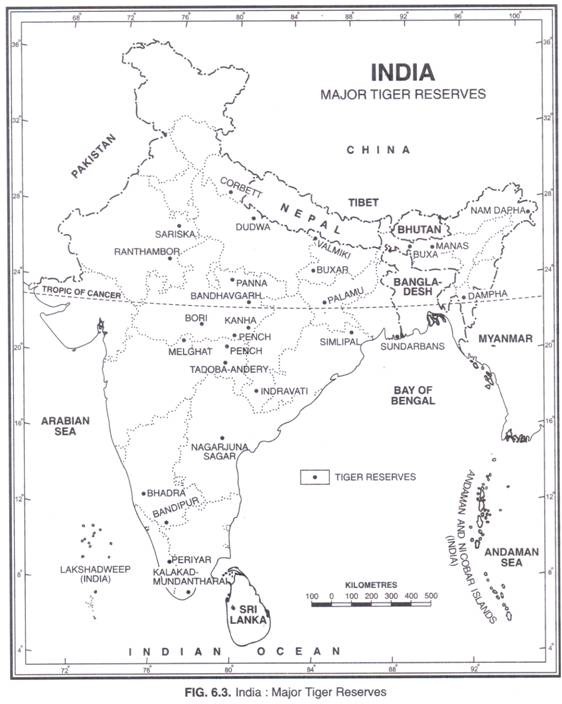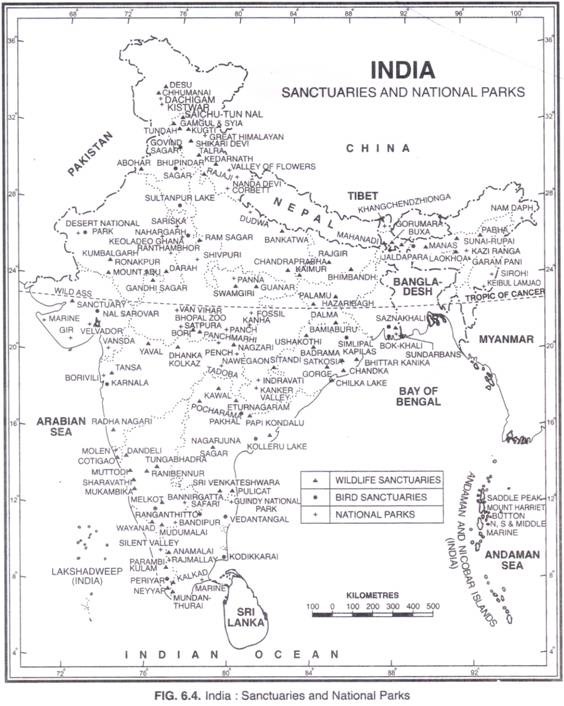Paragraph on the Preservation of Wildlife in India !
The fast dwindling forest cover in India has adversely affected wildlife in the country.
The number of several species has been drastically reduced, some are endangered species, the others are on the verge of extinction while some of them have already disappeared.
This is a very serious trend and will disturb the ecological balance. Therefore, it must be checked and reversed at all costs. This calls for urgent measures for preserving wildlife.
ADVERTISEMENTS:
Indian Board for Wildlife was constituted in 1952. The main purpose of the board was to advise the Government on the means of conservation and protection of wildlife, construction of national parks, sanctuaries and zoological gardens as well as promoting public awareness regarding conservation of wildlife.
The wildlife (Protection) Act, 1972 is a comprehensive law which has been adopted by all states except Jammu and Kashmir (which has its own Act). It governs wildlife conservation and protection of endangered species.
ADVERTISEMENTS:
The Act prohibits trade in rare and endangered species. An Inter-State Committee has been set up to review the Wildlife (Protection) Act, 1972 and other laws. The wildlife (Protection Amendment Bill 2002 proposes to enhance penalties for violation of the provision of the Act. Under this, export or import of endangered species and their products are governed by the conditions and stipulations lay down therein.
Project Tiger, one of the premier conservation efforts in the country was launched on 1 April 1973. It is a centrally financed scheme under which 27 Tiger Reserves have been set up in 17 states covering an area of about 37,761 sq km.
The tiger population had slid to a near extinction level before the implementation of Project Tiger. There were only 711 tigers in all the 27 tiger reserves in 1479. This figure rose to 1,141 in 1984, 1,327 in 1989, 1,396 in 1993 an 1,575 in 1997. Tiger has been declared as our national animal. Major tiger reserves are shown in Figure 6.3.
A tiger crisis cell has also been formed in the Ministry of Environment and Forests. Tiger has been declared as our national animal.
Project Elephant was launched in February 1992. Under this project, states having free-ranging population of wild elephants are being given financial as well as technical and scientific assistance to ensure long-term survival of identified viable populations of elephants in their natural habitats. Fourteen Elephant Reserves have been set up in 12 states.
ADVERTISEMENTS:
Operation Crocodile was launched in 1975. A Central Zoo Authority has been set up for the proper management of zoological parks in the country. It coordinates the activities of over 200 zoos and also supervises the exchange of animals. A national policy on zoos prepared by the authority provides appropriate directions to the government and other zoo operations.
The National Wildlife Action Plan (NWAP) provides the framework of strategy as well as programmes for conservation of wildlife. The first National Wildlife Action Plan of 1983 has been revised and new Wildlife Action Plan (2002-2016) has been adopted. The Indian Board of Wildlife is the apex advisory body overseeing and guiding the implementation of various schemes for wildlife conservation.
Under the Wildlife Protection Act, eight wildlife reserves have been developed throughout the country. The wildlife reserves are classified in two types: (f) national parks and (ii) wild life sanctuaries.
A National Park is a relatively large area of one or several ecosystems that have not been materially altered by human exploitation and occupation. Here, plant and animal species, geomorphological sites and habitats for special scientific education and recreation are preserved. A wild life sanctuary, similar to a national park, is dedicated to protect the wild life and concerned species.
ADVERTISEMENTS:
The difference between a sanctuary and a national park is subtle and confusing. In sanctuary, hunting without permission is prohibited and grazing or movement of cattle is regulated. Hunting and grazing are absolutely prohibited in national park. In a sanctuary human activities are allowed but in a national park the human interference is totally prohibited.
At present there are 89 National Parks and 490 Wildlife Sanctuaries covering an area of 1.56 lakh sq km which forms 4.75 per cent of the geographical area of the country.
The network wild life sanctuaries, bird sanctuaries and national parks is spread over all the biogeographic zones of the country including Himalayan, peninsular, marine, estuarine, riverine, mangrove and desert ecosystems. National Parks and Wildlife Sanctuaries are further put into five major categories. They are National Parks, Wildlife Sanctuaries, Tiger Project, Project Elephant and Bird Sanctuaries Fig. 6.4 shows the distribution of national parks and sanctuaries in India.

